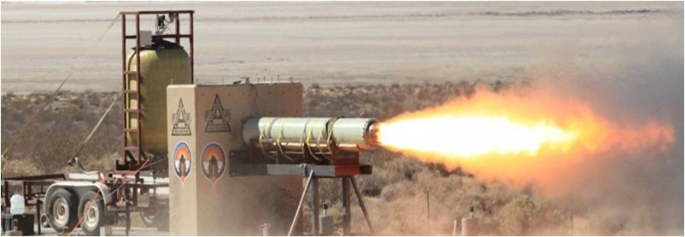
The secret’s out now – we’re planning on our first UK hybrid rocket firing on 3 October. I have to confess to being slightly nervous about the event. It’s all very well us running the world’s largest ‘Engineering Adventure’, promising to share all of the data as we go, and promising to conduct key tests in public, but doing our very first high-pressure firing with the world’s media present, when we don’t know exactly what will happen – what could possibly go wrong?
Actually, it’s probably not a lot. We’ve previously fired the hybrid in the US at a lower pressure – about 20 Bar (300 psi) – and all was well. Next month we’re going to use the Cosworth F1 engine and pump, doubling the feed pressure to 40 Bar (600 psi), which will hopefully make a lot more noise and flame – and a lot more thrust. This will be the next step in the development of the hybrid rocket, up to its eventual limit of around 1100 psi (76 Bar), at which point it should be delivering about 12 tonnes of thrust – the sort of power that BLOODHOUND SSC is going to need to get up to 1000 mph.
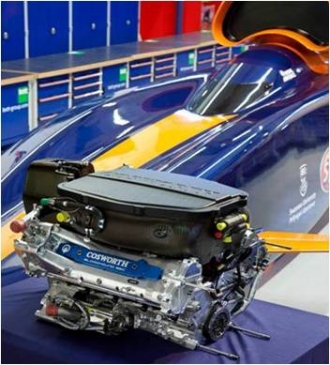 800 hp pump motor – thanks to Cosworth
800 hp pump motor – thanks to Cosworth
The hybrid firing requires a number of things to work together. First the Cosworth engine has to be running at high power, which is not as easy as it sounds. The engine is driving the rocket pump through a fixed gearbox, so it’s a bit like a F1 car pulling out of the pits in top gear – the engine will struggle to accelerate, and we will need to get the ratios exactly right to get to full speed. The Cosworth/pump system won’t be running at full speed for next month’s test, but we will still learn a lot about the pump performance.
 Pump and gearbox – now ready for testing
Pump and gearbox – now ready for testing
Once the pump is running, it will be pumping high test peroxide (HTP – concentrated hydrogen peroxide) under high pressure (40 Bar for this test) through the catalyst pack. To give you an idea of the pressure involved, I’ve just measured the palm of my hand – it’s about 1/100th of a square metre (10 cm by 10 cm). Hence a pressure of 40 Bar (i.e. 40 times atmospheric pressure) on the palm of my hand would exert a force of about 4 tonnes. That’s the weight of 3 saloon cars on the palm of my hand. 40 Bar is quite a lot of pressure.
The 80 layers of silver oxide mesh in the cat pack will break down this high-pressure HTP to release oxygen, water and heat (at about 600 dec C). The rocket fuel (a complex rubber compound, known as HTPB – you don’t want to know the long name) should then burn furiously in this hot oxygen, blasting out of the rocket nozzle and producing the required thrust. If the engine, gearbox, pump, valves, cat pack and fuel grain all work as we expect…… Want to know what’s going to happen when we press the button? Watch the TV news on 3 October – and wish us luck!
While this hybrid development run is important, it’s not critical for next year’s running. Our aim for 2013 is to get the Car supersonic in South Africa, to test the aerodynamics, chassis, steering, suspension, systems, etc., and make any improvements that we need before going for 1000 mph in 2014. To get the Car supersonic (and ideally up to 800 mph) next year, the Car’s EJ200 jet engine only needs about half of the hybrid rocket’s power. This can be delivered by using HTP only, and running the rocket as a ‘monopropellant’.
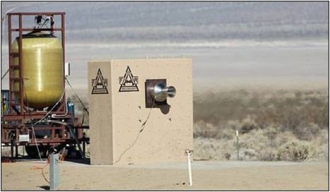 The ‘Mono’ Rig in action
The ‘Mono’ Rig in action
The HTP is still forced at high pressure though the cat pack, but is then fed straight to the rocket nozzle, without using any of the HTPB fuel. The hot oxygen/water vapour mix will produce several tonnes of thrust by itself – it’s not nearly as impressive (have a look at a previous monopropellant test and you’ll see what I mean), but it’s all that we need for next year.
What we will need for next year is a working Car. Great news here – it looks like we’ve got all of the funding now to complete BLOODHOUND SSC in time for next year. It’s been a huge effort by Richard Noble, our Project Director, to get us to this point, but finally its all coming together. This is allowing the engineering production to press ahead with the chassis manufacture, which should be on its wheels by Christmas. If you haven’t already paid your £10 to put your name on the Fin, then now’s the time – we’ll be building the Fin very soon.
I don’t know about anyone else, but I’m getting quite excited by seeing the various finished bits of Car coming out of the moulds and jigs. We are watching the gradual birth of a 1000 mph Car – something that the world has never seen before.
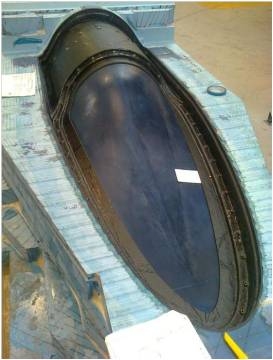 The Window Fixture for a 1000 mph Office
The Window Fixture for a 1000 mph Office
Cytec has delivered the first cockpit hatch and is now busy on the larger carbon fibre bits for the cockpit and nose of the Car. Meanwhile, the team at Hampson’s is equally busy completing the metal chassis bits for the back half of the Car.
The aerodynamics research is still a busy area for the team. This may seem odd, given that we’ve fixed the final shape of the Car, but there is a lot that we still don’t know. We are doing a number of modelling runs at different speeds, giving us a better idea of how the Car should handle as it speeds up and slows down. We are also working out the loads over the whole Car, panel by panel, so that the design team can properly stress the panels. Too weak and the bodywork could fail, too strong and the Car is heavier than it needs to be – so this process is key to the final bodywork manufacture.
We’re also starting to look at where we want to put sensors on the Car. Given that Swansea University has been the centre of the aerodynamic modelling, they obviously want some data to validate their computer models.
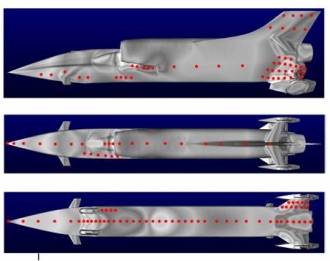 144 Pressure sensors, please
144 Pressure sensors, please
Their first look at this has produced a ‘wish list’ of 144 different pressure sensors for BLOODHOUND SSC. That sounds about right, given how complex the computer model is. Now we’ve got to work out where all the other system, load, temperature and vibration sensors are going to go, before wiring the Car (with several kilometres of wiring) early next year. It’s going to be a long list of sensors…. So whatever your particular technical interest in our Car, you will have plenty of data to look at when we start running next year.
One man who would have appreciated this data-intensive approach to record breaking was Neil Armstrong. During his visit to the BLOODHOUND Technical Centre 2 years ago, he emphasised the value of instrumentation on the Car, and the need to include it during the build. We were sad to say goodbye to Neil last month, but his advice remains a great way to sum up our approach to extreme record breaking.
Good news from South Africa. The precision grading of the causeway is underway and the results look great. This grading is being achieved with a very specialist piece of equipment – a road grader equipped with lasers – and driven, they assure me, by the best grader driver in South Africa. The man-made causeway has been my biggest worry in preparing the surface of Hakskeen Pan for BLOODHOUND.
 Grading with Lasers
Grading with Lasers
This kind of ‘heavy engineering’ on a dry lake bed, to return it to its original flat surface, is outside our experience (it’s outside anyone’s experience!). Now that the Northern Cape team has completed the work, I’m feeling much happier about it. The annual rains (due to start at the end of the year) will complete the job of returning the surface to its natural state. Then, thanks to the Northern Cape Government, we really will have the world’s best race track.
Our Education Programme remains a key part of BLOODHOUND, with over 5000 schools already in the programme and some 500 volunteer BLOODHOUND Ambassadors to support them. If your school hasn’t signed up to this (free!) programme then please do it today – the feedback we get from schools is all about how exciting the kids find the science and technology of 1000 mph, which is just what we’re after.
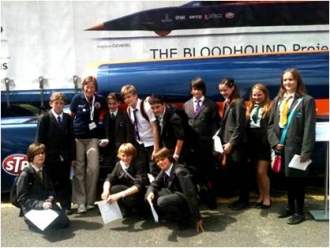 BLOODHOUND Education – Sharing the Adventure
BLOODHOUND Education – Sharing the Adventure
We’re also working on other ways to get the education message out there – and it’s not always pleasant work. Last week I was a Silverstone with the BLOODHOUND Radical, showing a couple of journalists (from The Sun and Radio 1) how I’m going about training for BLOODHOUND by improving my driving skills. While we were there, a BBC team were making a new education-based series on how human beings cope with extremes. The Radical at Silverstone is a good way to do this – the car will regularly pull 2G round the high-speed Grand Prix circuit track.
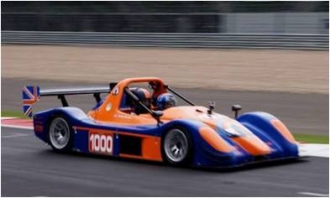 Up to 2G at Silverstone
Up to 2G at Silverstone
To demonstrate how the varying G forces can affect your body, they had myself and their presenter in 2 identical Radicals, as passengers for 6 racing laps … blindfolded, just to make it harder! The aim was to find out if, given my fighter pilot background, I can cope better with the resulting physical stress than Tim the BBC presenter. Good news, our on-board stress monitors showed that I can – so I get to keep my job. However, we both felt a little queasy and unsteady after the experience (even if we didn’t admit it on camera). Next month, I’m taking Tim flying to find out how he copes with some proper G-forces in my world – can’t wait.
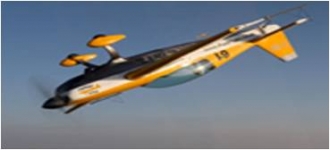 Brace yourself, Tim!
Brace yourself, Tim!


